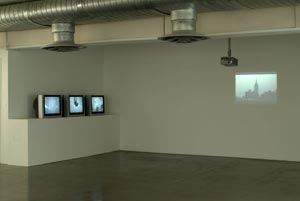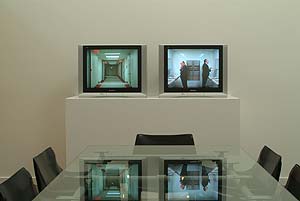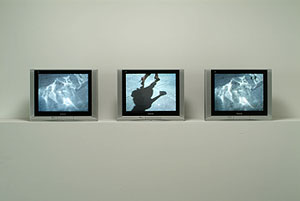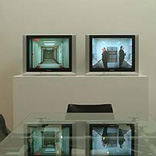John Pilson's exhibit is composed of a series of films and photographs, St. Denis being the centerpiece of the entire exhibit. The rest of the videos are stray satellites that feel like souvenirs or mementos from the main show, a.k.a. St. Denis-Outtakes Re-edited.
At first I was having a hard time reading the artwork. It felt like Pilson was speaking a fascinating new language that, while familiar, was not immediately understandable. His works have a narrative without having any real structure. They don't have a story so much as a situation in which characters exist. They are not littered with heavy symbols and great ideas. They don't try to change the world—yet they have a strong and uncompromising presence. Conventional notions of coherence have been edited out of them to the point that calling them bizarre just doesn't cut it. The films are so abstract and the control he has over them is so strong that they might as well exist entirely inside Pilson's head.
Abstract, but at the same time uniquely vital and human—I think that is what is so difficult to read at first. So many videos in gallery settings deal with abstraction, but lack any kind of human hook. They may feature humans, but their humans give us no insight into their humanity. Pilson’s perspective changes my preconceived notions about video art.
Vladimir Nabokov had the ability of composing whole scenes out of graceful notes and seemingly insignificant details that imbibe his characters with more life than certain living humans in our environment posses. Every time I manage to totally engross myself in one of Nabokov's novels, the real world seems unsatisfactory by comparison. After staring at Pilson's work for hours, his little vignettes left me with the same aftertaste.
Above the Grid and St Denis most specifically reflect that Nabokovian quality. Above the Grid, features a pair of suited slaves of corporate America breaking spontaneously into doo-wop on the top floors of some horror of modernist architecture and then playing dodge ball and king of the hill, before coming back down into the real world. The stark, frigid, daunting hallways of business buildings, another favorite motif of Pilson's, are to blame in a large part for that feeling of abstractedness and distance from anything really real, anything familiar to us. The inhumanness of the hallways and the space in general clashes strongly with the doo-wop love songs the businessmen are singing ad nauseam.
The building in St Denis, on the other hand, is not just another office space above the streets; it is The St Denis, a very particular, pedigreed building. Built as a grand Manhattan hotel back in the day, it served as the place of Alexander Graham Bell's first public demonstration of the telephone. Marcel Duchamp, after divorcing art for chess, engaged furtively in acts of infidelity in a secret studio located there. Today the building is occupied by psychologists, miscellaneous therapists and other voodoo priests. The place is rife with different architectural styles from over a century of continual improvements and additions that it is almost hard to believe his film was shot entirely in one building.
The people in the building all seem to be comfortable with where they are, enforcing the surroundings that in turn confine them. The accordion of the woman in the bathroom matches the tile of the bathroom. The kids that are listening to the guru sit on carefully chosen items (milk crate, Mac, some sort of picnic chair). The wholesome Tammy Fayelook-alikes gaze absently at crystal, antiques, a framed photograph of a Roman copy of some Greek sculpture, and then push a chandelier down a hallway. The janitor taps his drumstick against the doors. An old man and two girls sit on a small staircase and perform some new age ritual to the building. And so on.
The first impulse when we try to describe someone is to say what they do, and Pilson doesn't resort to that. His characters engage in quixotic endeavors that give more insight into who they are than any kind of stereotype-engendering statement of occupation such as "businessman", "psychologist", "therapist" or "voodoo priest."
Above the Grid lets us take a stroll down the hallways of the psyche of a culture of type-A personalities, while St Denis does this with a more generalized Manhattan. In each piece the building stands for a body of sorts and the people in it are its soul.
Images courtesy Artpace.
Stevan Zivadinovic is a mecha-critic from outer space currently living incognito in the city of "San Antonio".







